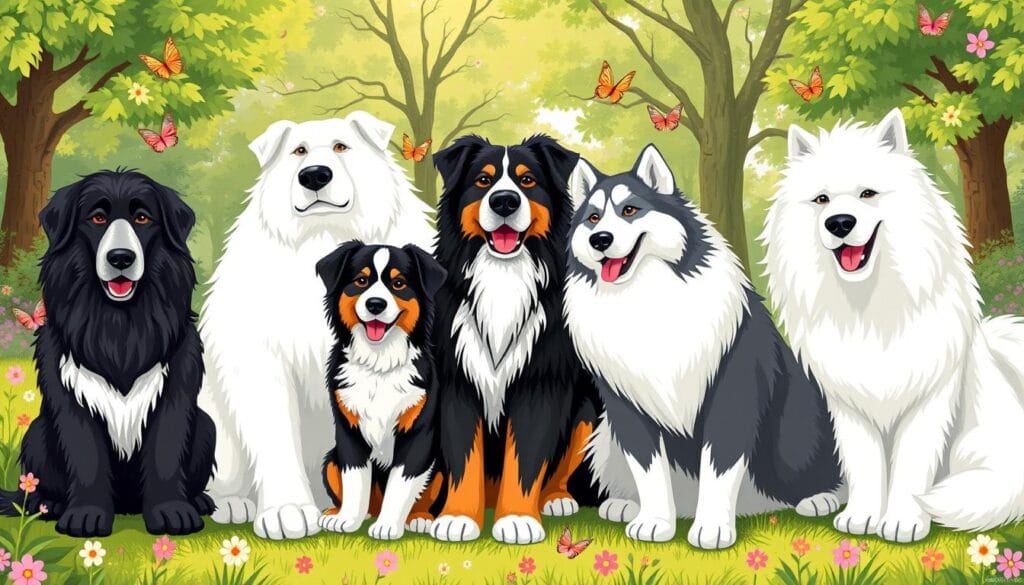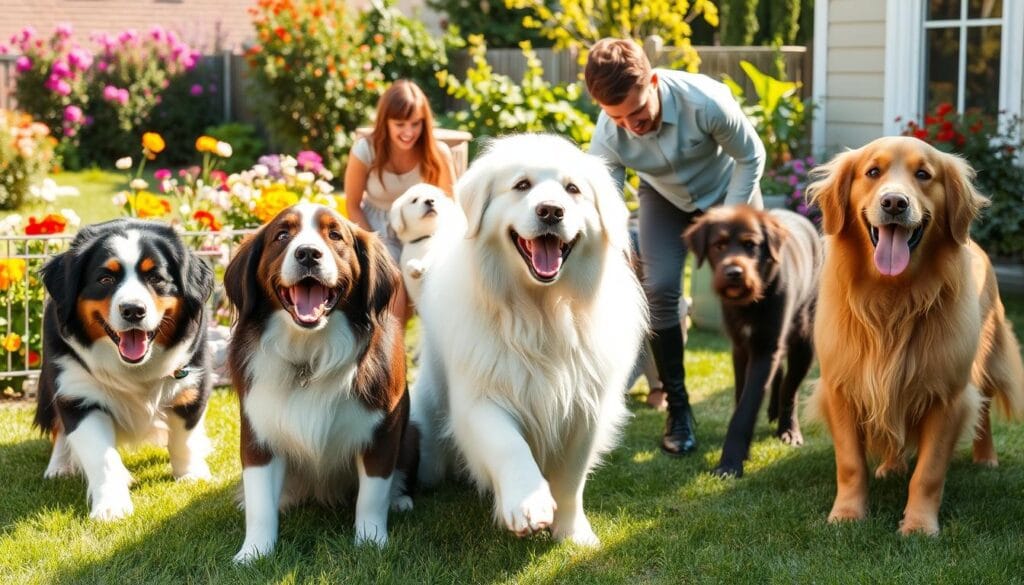Big fluffy dog breeds are loved by many in America. They are big, have fluffy coats, and are very affectionate. When picking a big fluffy dog, think about their personality, grooming, and exercise needs. The best ones match their owner’s lifestyle and bring lots of love.
These dogs are loyal and gentle, perfect for families with kids. They need regular grooming and exercise to stay happy. With so many breeds, choosing the right one can be tough. This article will help you understand the different big fluffy dog breeds and what makes them great companions.
Table of Contents
Understanding Big Fluffy Dog Breeds
Fluffy large dog breeds have thick, dense coats that need regular grooming. They are known for being loyal and gentle, making them great family pets.
These dogs are big, with some weighing over 100 pounds. Their coats vary in length and texture but are always thick and fluffy. Regular brushing is key to prevent shedding. Examples include the Samoyed, the Old English Sheepdog, and the Newfoundland.
What Defines a Fluffy Dog Breed
A fluffy dog breed has a thick, dense coat. This can be long and flowing or short and compact. Popular fluffy dog breeds are loved for their looks and loyalty.
Characteristics of Large Dog Breeds
Large dog breeds are big, strong, and loyal. They’re great for active families or those who love the outdoors. Key traits include:
- Loyalty and protectiveness
- Intelligence and trainability
- High energy levels, needing lots of exercise
Benefits of Choosing a Large Fluffy Dog
Choosing a large fluffy dog brings many joys. They are social and love being around their family. With the right care, fluffy large dog breeds can be wonderful family members.
Most Popular Big Fluffy Dog Breeds in America
Americans love big, fluffy dogs for their gentle nature and loving personalities. These dogs are perfect for families with children. They are patient, loyal, and always ready to show love. Here are some of the most popular big fluffy dog breeds in America:
- Samoyed: Known for their thick, white coats and friendly demeanor
- Newfoundland: Famous for their massive size and gentle giant reputation
- Bernese Mountain Dog: Admired for their distinctive tri-colored coats and calm temperament
These breeds are great for families because they are patient and loving. The fluffy dog breeds list shows the variety of big, fluffy dogs Americans love. With the right care, these dogs can be wonderful family pets.
What makes these breeds popular is their unique size, coat, and temperament. For example, Samoyeds need regular grooming, while Newfoundlands need lots of space and exercise. Knowing these needs helps families decide if a big, fluffy dog is right for them.

Researching these breeds helps families choose the perfect dog. Whether you want a gentle giant or a playful friend, the fluffy dog breeds list has it all.
| Breed | Size | Coat | Temperament |
|---|---|---|---|
| Samoyed | Medium-Large | Thick, White | Friendly, Outgoing |
| Newfoundland | Large | Thick, Black | Gentle, Calm |
| Bernese Mountain Dog | Large | Thick, Tri-colored | Calm, Intelligent |
Temperament and Personality Traits
Fluffy dog breeds are perfect for families because of their friendly nature. They are gentle and loving, making them great with kids. These dogs are very loyal and often called velcro dogs because they love to stay close.
These breeds are smart, social, and easy to adapt to different homes. They get along well with children and other pets if they’re socialized right. Here are some important traits to know:
Social Characteristics
- Good with children: Fluffy dog breeds are patient and gentle, perfect for families.
- Intelligence: Many are smart and learn quickly.
- Adaptability: They do well in various homes, from small apartments to big yards.
Fluffy dog breeds are great for families. They are loyal and loving, perfect for families who love the outdoors. With the right socialization, they can also live well with other pets.

Family Compatibility
Fluffy dog breeds are ideal for families looking for a loyal friend. They are friendly with kids and can adjust to different homes. By understanding their social traits and family fit, families can choose the best fluffy pet for them.
Grooming Requirements and Maintenance
Big fluffy dog breeds need regular grooming to avoid matting and tangling. Daily brushing removes loose hair and spreads skin oils. This keeps their coat healthy and shiny.
They also need to be bathed often, based on their lifestyle and where they live. Dogs that spend a lot of time outside might need weekly baths. Dogs mostly indoors might only need a bath once a month.
Other grooming needs include nail care and shedding management. Trimming their nails regularly is key to prevent discomfort and health issues. Shedding management means brushing and bathing often to cut down on loose hair and prevent mats.
Some big fluffy dog breeds shed a lot, which can be tough for owners. But, with consistent grooming and care, you can manage their shedding. This keeps their coat in check and prevents excessive shedding.
Here are some grooming tips for big fluffy dog breeds:
- Brush their coat daily to prevent matting and tangling
- Bathe them regularly, depending on their lifestyle and environment
- Trim their nails regularly to prevent overgrowth
- Manage shedding through regular brushing and bathing
Exercise Needs and Space Requirements
Fluffy giant dog breeds need regular exercise to stay healthy and happy. They require daily walks and playtime to burn off energy and keep their minds sharp. The amount of exercise needed varies based on their age, size, and individual traits.
Young fluffy giant dog breeds need more exercise than older ones. They have lots of energy and need physical activity to grow properly. A daily routine with at least 30 minutes of exercise, like walking or playing fetch, is best for them.
Fluffy giant dog breeds also need lots of space to move around. They need spacious living areas to stretch out and exercise. A big backyard or a nearby park is perfect for them, as they love to run and play.
Daily Exercise Requirements
- At least 30 minutes of exercise per day
- Daily walks and playtime
- Regular mental stimulation and training
Ideal Living Spaces
Ideal living spaces for fluffy giant dog breeds include large homes with big yards. Apartments with nearby parks or green areas are also great. These breeds need lots of space to move and exercise, and they do best in places that offer them freedom.
Health Considerations for Large Fluffy Dogs
Big fluffy dog breeds can be great pets, but they face health challenges. Regular vet visits are key to catch and manage these issues. A good diet and active lifestyle also play a big role in keeping them healthy.
Large fluffy dogs might get hip dysplasia, cancers, and eye problems. Knowing these risks and acting early can help. For instance, keeping them at a healthy weight can lower hip dysplasia risk.
Here are some health tips for large fluffy dogs:
- Regular vet visits to check their health and catch problems early
- A balanced diet that fits their nutritional needs
- Enough exercise to keep them at a healthy weight and avoid obesity
- Regular grooming to prevent fur matting and tangling
By understanding these health tips and taking action, you can ensure your big fluffy dog lives a long, healthy life.
| Health Issue | Description | Prevention/Management |
|---|---|---|
| Hip Dysplasia | A genetic condition that can cause arthritis and mobility problems | Maintaining a healthy weight, regular exercise, and veterinary check-ups |
| Cancer | A disease that can affect big fluffy dog breeds, such as lymphoma and osteosarcoma | Regular veterinary check-ups, a balanced diet, and a healthy lifestyle |
| Eye Problems | Conditions such as cataracts and progressive retinal atrophy that can cause vision loss | Regular eye exams, a balanced diet, and a healthy lifestyle |
Training and Socialization Tips
Training and socialization are key for fluffy dog breeds in apartments. They help build a strong bond between dog and owner. They also make the dog calm and confident in different places.
For fluffy dogs in apartments, use positive training methods. Reward-based and clicker training work well. They encourage good behavior and prevent problems like barking and chewing.
Basic Training Guidelines
- Establish a routine and set clear boundaries
- Use positive reinforcement techniques, such as treats and praise
- Be consistent and patient, as training takes time
Early Socialization Importance
Early socialization is crucial for fluffy dogs in apartments. It makes them comfortable in new places and with people. Take them on walks, to dog parks, and for meetings with strangers.
Common Behavioral Challenges
Fluffy dogs in apartments might face issues like separation anxiety and destructive behavior. To solve these, give them mental challenges like puzzle toys. Also, increase their exercise and physical activities.
Cost of Owning Big Fluffy Dog Breeds
Owning a dog is a big deal, and best big fluffy dogs are no different. The cost depends on the dog’s size, age, and health. It’s key to think about the upfront costs, monthly bills, and health insurance.
Initial costs include the dog’s price, spaying or neutering, and shots. Monthly bills cover food, grooming, and care like heartworm meds and flea control.
Initial Purchase Costs
- Purchase price: This can range from $500 to $2,000 or more, depending on the breed and bloodlines.
- Spaying or neutering: This can cost between $50 to $500, depending on the veterinarian and location.
- Vaccinations: The initial vaccination series can cost between $50 to $100.
Monthly Maintenance Expenses
Monthly costs for a big fluffy dog can quickly add up. Food, grooming, and care can cost $50 to $200 a month. This depends on the dog’s size and needs.
Healthcare and Insurance Considerations
Big fluffy dogs might face health issues like hip dysplasia and eye problems. Pet insurance can help with vet bills. It’s important to compare insurance options to find the best for your dog.
Choosing the Right Breed for Your Lifestyle
Choosing a big fluffy dog breed needs careful thought. Fluffy dog breeds for families are great with kids because they’re gentle. Fluffy dog breeds for apartments are perfect for city living since they need less space and exercise.
Think about these points to pick the right dog:
- Living space: A small apartment needs a dog that doesn’t need much room or exercise.
- Family size: A big family should choose a breed that’s patient and gentle with kids.
- Activity level: If you’re always on the move, pick a breed that loves to stay active.
A table with popular big fluffy dog breeds’ details can help you decide:
| Breed | Size | Exercise Needs | Family-Friendly |
|---|---|---|---|
| Samoyed | Medium | Regular | Yes |
| Newfoundland | Large | Regular | Yes |
| Bichon Frise | Small | Minimal | Yes |
By looking at these factors and breed traits, you can find the ideal big fluffy dog. Whether you want a breed for a family or for apartment living, there’s one out there for you.
Conclusion: Finding Your Perfect Fluffy Companion
Big fluffy dog breeds can be amazing companions for families. Whether you like the gentle giants like the Bernese Mountain Dog or the playful Samoyed, there’s a perfect match for you.
Before choosing your new pet, think about your home, how active you are, and how much grooming you can do. With the right breed and care, these big fluffy dogs will bring joy and companionship. Take your time to find the perfect match, and you’ll get a loyal and devoted pet.

